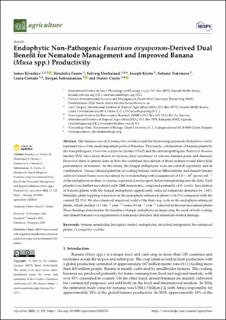| dc.contributor.author | Kisaakye, James | |
| dc.contributor.author | Fourie, Hendrika | |
| dc.contributor.author | Haukeland, Solveig | |
| dc.contributor.author | Kisitu, Joseph | |
| dc.contributor.author | Nakimera, Solomy | |
| dc.contributor.author | Cortada, Laura | |
| dc.contributor.author | Subramanian, Sevgan | |
| dc.contributor.author | Coyne, Danny | |
| dc.date.accessioned | 2022-07-05T08:55:31Z | |
| dc.date.available | 2022-07-05T08:55:31Z | |
| dc.date.created | 2022-05-10T15:36:16Z | |
| dc.date.issued | 2022-01-18 | |
| dc.identifier.citation | Agriculture. 2022, 12 (2), 1-17. | en_US |
| dc.identifier.issn | 2077-0472 | |
| dc.identifier.uri | https://hdl.handle.net/11250/3002707 | |
| dc.description.abstract | The banana weevil (Cosmopolites sordidus) and the burrowing nematode Radopholus similis represent two of the most important pests of bananas. Previously, colonization of banana plants by the non-pathogenic Fusarium oxysporum (isolate V5w2) and the entomopathogenic Beauveria bassiana (isolate WA) have been shown to increase host resistance to various banana pests and diseases. However, there is limited data on how the combined inoculation of these isolates would affect field performance of bananas. In this study, the fungal endophytes were inoculated separately and in combination. Tissue cultured plantlets of cooking banana cultivar Mbwazirume and dessert banana cultivar Grande Naine were inoculated by root drenching with a suspension of 1.0 × 107 spores mL−1 of the endophytes on three occasions, separated 4 weeks apart, before transplanting into the field. Each plantlet was further inoculated with 1800 nematodes, composed primarily of R. similis. Inoculation of banana plants with the fungal endophytes significantly reduced nematode densities by >34%. Similarly, plant toppling was lower in the endophyte-enhanced plants (<16.5%) compared with the control (23.3%). We also observed improved yield of the first crop cycle in the endophyte-enhanced plants, which yielded >11 t ha−1 year−1 versus 9 t ha−1 year−1 achieved in the non-inoculated plants. These findings demonstrate the benefits of fungal endophytes in improving the yield of both cooking and dessert bananas via suppression of nematode densities and nematode-related damage. | en_US |
| dc.language.iso | eng | en_US |
| dc.publisher | MDPI, Basel, Switzerland | en_US |
| dc.rights | Navngivelse 4.0 Internasjonal | * |
| dc.rights.uri | http://creativecommons.org/licenses/by/4.0/deed.no | * |
| dc.title | Endophytic Non-Pathogenic Fusarium oxysporum-Derived Dual Benefit for Nematode Management and Improved Banana (Musa spp.) Productivity | en_US |
| dc.title.alternative | Endophytic Non-Pathogenic Fusarium oxysporum-Derived Dual Benefit for Nematode Management and Improved Banana (Musa spp.) Productivity | en_US |
| dc.type | Peer reviewed | en_US |
| dc.type | Journal article | en_US |
| dc.description.version | publishedVersion | en_US |
| dc.rights.holder | © 2022 by the authors | en_US |
| dc.source.pagenumber | 1-17 | en_US |
| dc.source.volume | 12 | en_US |
| dc.source.journal | Agriculture | en_US |
| dc.source.issue | 2 | en_US |
| dc.identifier.doi | 10.3390/agriculture12020125 | |
| dc.identifier.cristin | 2023198 | |
| dc.relation.project | EC/H2020/727624 | en_US |
| dc.source.articlenumber | 125 | en_US |
| cristin.ispublished | true | |
| cristin.fulltext | original | |
| cristin.qualitycode | 1 | |

